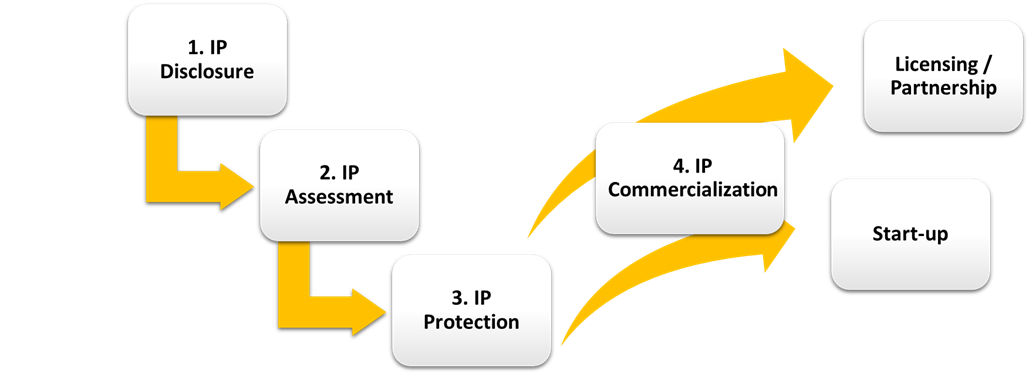Commercialization Process
Overview
The Office of Research Services (ORS) facilitates the development, protection, and commercialization of IP developed at Ontario Tech University. We work with the creator(s) to launch new start-ups or seek partners to mobilize the research outcomes to the market.

There are 4 necessary steps to tech transfer if you elect to commercialize through the university. If you elect to commercialize on your own, follow step 1 only.
Step 1: IP Disclosure
An IP disclosure is a document that details the information necessary to evaluate the novelty of the IP, the inventorship, the commercial potential, and any obligations to research sponsors.
Creators must disclose IP to the university if they intend to commercialize.
All IP disclosure forms are to be submitted to the IP Officer. Creator(s) can indicate in the IP disclosure form if they wish to work with the University to commercialize their technology or commercialize on their own.
The IP Officer will arrange a meeting with the creator(s) to go over the disclosure form. During this meeting, the creator(s) will be reminded of their obligations to the university if they elect to commercialize on their own.
If the creator(s) elect to have the university to be the commercialization agent, then proceed to step 2 and 3.
Step 2: IP Assessment
Our team will review the submitted IP disclosure form and perform a due diligence analysis that will include novelty, prior art search, technology readiness level (TRL), market size, and competitive landscape. This analysis helps our team to decide if the university should invest into this IP, and to formulate a protection strategy and the best knowledge mobilization avenue (eg. start-up, licensing, partnership).
The university will consider investing in IP that have reached the validation stage in development (TRL 4). If your IP is approved for commercialization, the rights to the IP must be assigned to the university. In the case, the university decides not to proceed with your IP after the assessment, then ownership of the IP will be retained by the creator(s).

Step 3: IP Protection
A critical step in commercialization is to keep your IP confidential from any public disclosures prior to IP protection. The university will ensure the IP is protected and that it will be given proper stewardship to ensure its further development to its highest potential.
IP protection is a costly and a complex process. The university provides expertise to navigate through this complex process in a strategic approach. Our team will take the lead in securing IP assets and handling all legal and administrative expenses associated with IP protection and prosecution.
Step 4: IP Commercialization
We work with the creator(s) to identify potential industry receptors for the IP. We facilitate any necessary confidential agreements, material transfer agreements, research agreements, or commercial agreements to secure industry receptors.
As the commercialization lead, the university will negotiate on behalf of the creator(s) any business deal that brings benefit back to the creator(s) and the university.
Additionally, we identify grants that aim to de-risk the technology and provide understanding of product-market-fit and the competitive landscape.
- Natural Sciences and Engineering Council of Canada Idea to Innovation Program—with granting cycles four times a year, the program helps businesses commercialize new concepts. The mandate of this competitive program is to accelerate pre-commercialization research that will lead to the adoption of a new technology by a Canadian company. The involved application process includes sections requiring information on an IP protection and commercialization strategy. We assist researchers with the writing component as part of the grant requirements.
- Lab2Market—The Lab2Market Program is a 16-week program to help researchers validate their ideas with the purpose of finding business/commercial value. The program is based on similar programs that have found success in other parts of the world, but with a Canadian twist.
- Ontario Centres of Innovation Market Readiness Program—helps researchers advance to the next stages of commercialization by turning valuable research into a marketable product or service.
In some cases, creator(s) may elect to launch a new start-up around the protected IP. We facilitate any licensing agreement needed to enable the transaction. Plus, identify any grants that the start-up can be eligible for, while coordinating efforts with our Brilliant Catalyst incubator.
- Mitacs Accelerate Entrepreneur—Funds student and postdoctoral entrepreneurs to further develop the research or technology at the core of their start-up business. With the support of an approved incubator, Mitacs funding helps students and postdoctoral fellows build their professional entrepreneurial skills, with the goal of commercializing their start-up’s technology, product, or service through funded internships. In short, Accelerate Entrepreneur pays students and postdoctoral fellows to grow their start-ups and get to market faster.
- Industrial Research Assistance Program—provides innovation and funding services for businesses to increase economic development for companies.
Brilliant Catalyst is the official Ontario Tech University incubator, which aims to cultivate a spirit of innovation. They offer resources and services to help start your business such as:
- Business development advice
- Access to legal advice
- Access to experienced entrepreneurs
- Market research resources
- Pitch programs
- Space for your business
Visit the Brilliant Catalyst website for more information.
